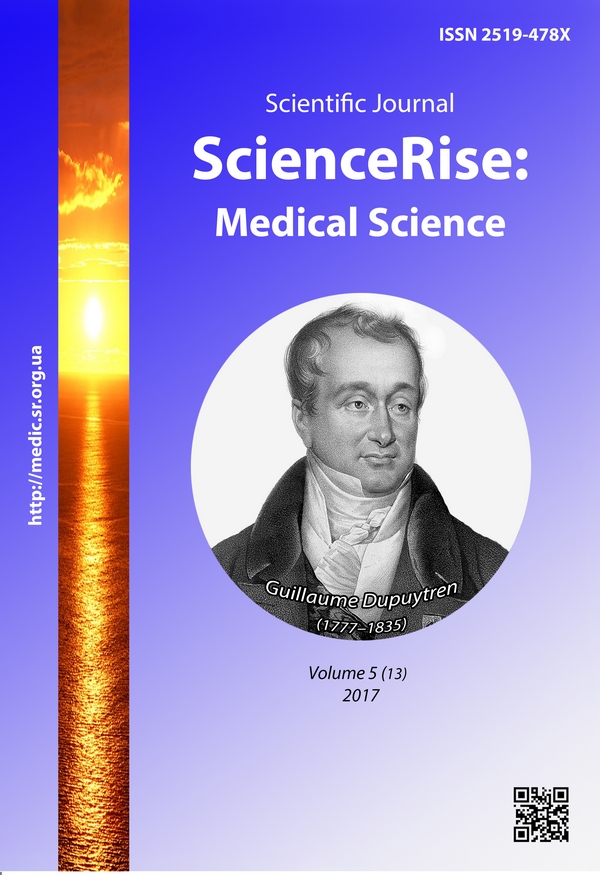Features of metabolic disorders in patients with hernias of lumbar spine associated with arterial hypertension
DOI:
https://doi.org/10.15587/2519-4798.2017.102278Keywords:
lumbar spine, hernias, arterial hypertension, biochemical markers, interleukins, metabolic disordersAbstract
The combination of arterial hypertension (AH) with the spine pathology is a natural manifestation of connected structural-functional disorders.
Aim is to determine the features of metabolic disorders in the organism of patients with hernias of lumbar spine, associated with arterial hypertension (AH), on the base of clinical-biochemical and immunological markers.
Materials and methods. The study was carried out in 2016 on the base of SI “Institute of spine and joints pathology, named after prof. M.I. Sitenko, NAMS of Ukraine”. There were examined 37 patients with lumbar spine hernias: 23 – without concomitant pathologies, 14 – in association with AH of 1–2 degrees of І–ІІ stage. The control group – 30 persons, 13 men and 17 women. General protein, glycoproteins, chondroitin sulfates, C-reactive protein, glucose, urea, creatinine, β-lipoproteins, calcium, ALAT, ASAT, CPK, LDG, IL-1, IL-4 and IL-6 were determined in blood serum.
Results of research. The content of interleukins in the group of patients with AH was higher than in the group of patients without it. In the group of patients with AH IL-1 was increased in 10,5 times, IL-6 – in 5,3 times that testifies to heavier immunologic disorders in patients with AH. The content of glycoproteins in patients without AH was increased by 55,8 %, in patients with AH – in 2,1 times comparing with control. The content of chondroitin sulfates in patients with hernias without AH was increased in 2,8 times, in ones with AH – in 4 times. LDG was increased, CPK – decreased in both groups. β-lipoproteins in blood of patients without concomitant AH was increased by 44,6 %, in patients with AH – by 67 %.
Conclusions. In patients with lumbar spine hernias, associated with AH were observed heavier inflammatory-destructive disorders in the cartilage tissue. The increased content of β-lipoproteins in blood of patients with lumbar spine hernias, associated with AH comparing with patients without it may indicate age disorders of lipids metabolism. IL-1 and IL-6 уin patients with lumbar spine hernias, associated with AH were higher comparing with patients without it
References
- Polyakov, V. Ya., Nikolaev, Yu. A., Mitrofanov, I. M., Dolgova, N. A., Shchepankevich, L. A., Sevost'yanova, E. V. (2015). Osobennosti vstrechaemosti arterial'noy gipertenzii, sochetannoy s dorsopatiey pozvonochnika, v sovremennoy terapevticheskoy klinike. Uspekhi sovremennogo estestvoznaniya, 4, 54–58.
- Fortin, M., Lapointe, L., Hudon, C., Vanasse, A., Ntetu, A. L., Maltais, D. (2004). Multimorbidity and quality of life in primary care: a systematic review. Health and Quality of Life Outcomes, 2 (1), 51. doi: 10.1186/1477-7525-2-51
- Valderas, J. M., Starfield, B., Sibbald, B., Salisbury, C., Roland, M. (2009). Defining Comorbidity: Implications for Understanding Health and Health Services. The Annals of Family Medicine, 7 (4), 357–363. doi: 10.1370/afm.983
- Zhuravlev, Yu. I., Sheremet, S. A., Thorikova, V. N. (2014). Mediko-social'nye aspekty okazaniya ortopedo-travmatologicheskoy pomoshchi pacientam s polimorbidnymi sostoyaniyami. Nauchnye vedomosti Belgorodskogo gosudarstvennogo universiteta. Seriya: Medicina. Farmaciya, 25 (4 (175)), 142–149.
- LeMaitre, C. L., Freemont, A. J., Hoyland, J. A. (2005). The role of interleukin-1 in the pathogenesis of human Intervertebral disc degeneration. Arthritis Research & Therapy, 7 (4), 732–745. doi: 10.1186/ar1732
- Nikolaev, Y. A., Mitrofanov, I. M., Polyakov, V. Y., Dolgova, N. A. (2014). Arterial hypertension associated with somatic pathology in present-day practice of internal diseases. Health, 6 (1), 94–98. doi: 10.4236/health.2014.61015
- Kulikov, V. P., Mogozov, A. V., Graf, E. V., Smirnov, K. V. (1995). Energeticheskaya dopplerografiya v diagnostike patologicheskoy izvitosti brahiocefal'nyh arteriy. Vizualizaciya v klinike, 7, 13–16.
- Erdakova, T. K., Salamatina, L. V., Buganov, A. A. (2007). Osobennosti endotelial'noy funkcii u bol'nyh arterial'noy gipertenziey na Kraynem Severe. Profilaktika zabolevaniy i ukreplenie zdorov'ya, 10 (2), 34–38.
- Tymoshenko, O. P., Voronina, L. M., Kravchenko, V. M. et. al. (2003). Klinichna biokhimiya. Kharkiv: Zoloti Storinky, 239.
- Glanc, S. (1998). Mediko-biologicheskaya statistika. Moscow: Praktika, 459.
- Shymon, V. M., Shymon, M. V., Vasylynets, M. M., Pushkash, I. I., Heleta, M. M. (2013). Reabilitatsiya khvorykh z hryzhamy mizhkhrebtsevykh dyskiv pislya likuvannya preparatom inhibitorom faktoru nekrozu pukhlyn infliksimab. Litopys travmatolohiyi ta ortopediyi, 1-2, 150–152.
- Koroy, P. V. (2016). Osteoartryt: klynyka, dyahnostyka, lechenye. Vestnyk molodoho uchenoho, 2, 22–28.
- Isaykin, A. I., Ivanova, M. A., Kavelina, A. V., Smirnova, D. S., Yahno, N. N. (2016). Diskogennaya lyumbalgiya. Rossiyskiy medicinskiy zhurnal, 24, 1599–1605.
- Deduh, N. V., Bengus, L. M. (2013). Mekhanizmy spontannoy rezorbcii gryzhi mezhpozvonochnogo diska. Bol'. Sustavy. Pozvonochnik, 1 (9), 58–66.
- Pohoryelov, V. V., Zhukov, V. I., Telehina, N. D. (2013). Vplyv prozapal'nykh mediatoriv na perebih deheneratyvno-dystrofichnykh protsesiv khrebta u khvorykh z dyskohennoyu radykuloishemiyeyu. Ukrayins'kyi medychnyi al'manakh, 16 (1), 85–88.
Downloads
Published
How to Cite
Issue
Section
License
Copyright (c) 2017 Volodymyr Radchenko, Valentin Piontkovsky, Artem Skidanov, Dmytro Morozenko, Iryna Korzh

This work is licensed under a Creative Commons Attribution 4.0 International License.
Our journal abides by the Creative Commons CC BY copyright rights and permissions for open access journals.
Authors, who are published in this journal, agree to the following conditions:
1. The authors reserve the right to authorship of the work and pass the first publication right of this work to the journal under the terms of a Creative Commons CC BY, which allows others to freely distribute the published research with the obligatory reference to the authors of the original work and the first publication of the work in this journal.
2. The authors have the right to conclude separate supplement agreements that relate to non-exclusive work distribution in the form in which it has been published by the journal (for example, to upload the work to the online storage of the journal or publish it as part of a monograph), provided that the reference to the first publication of the work in this journal is included.









